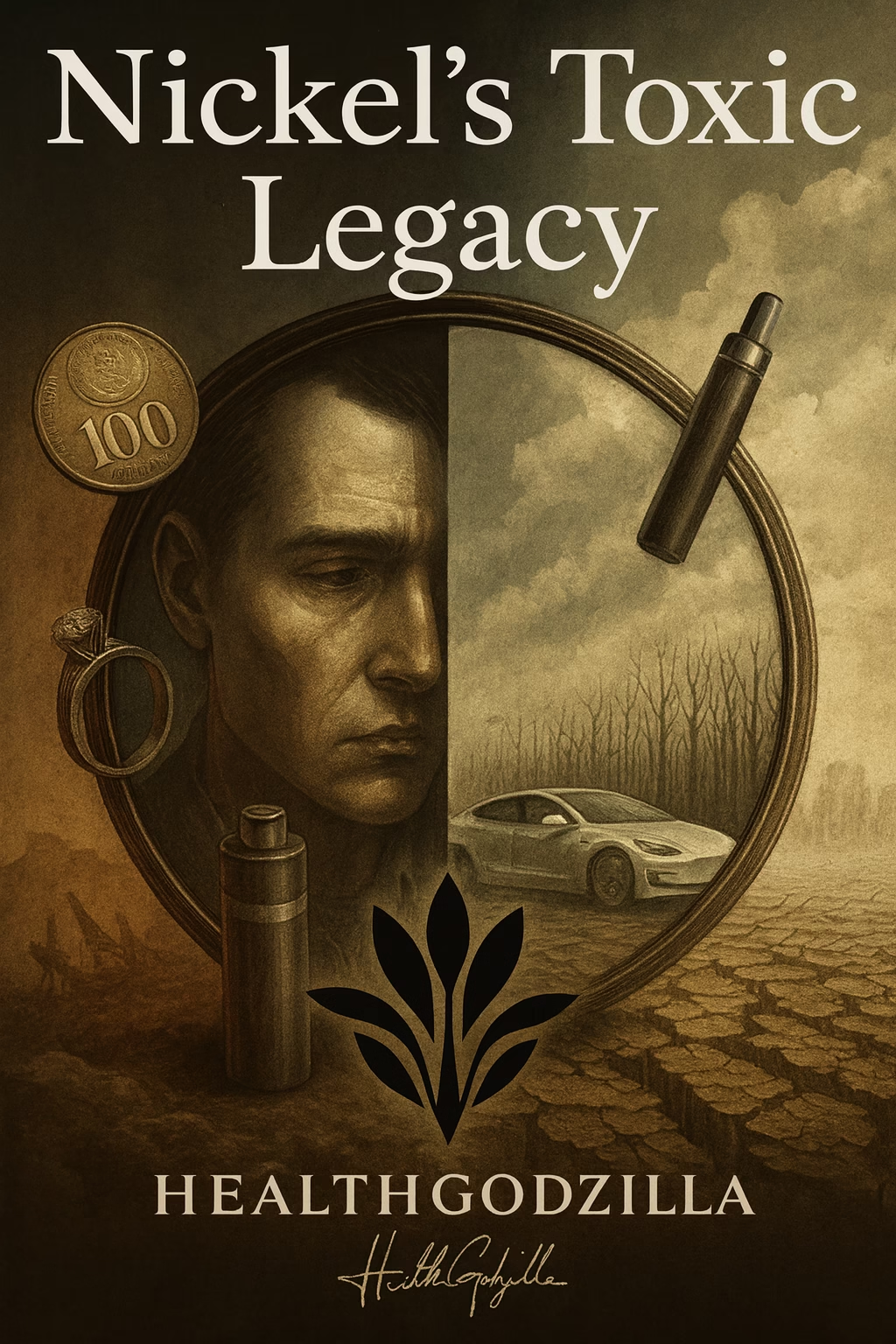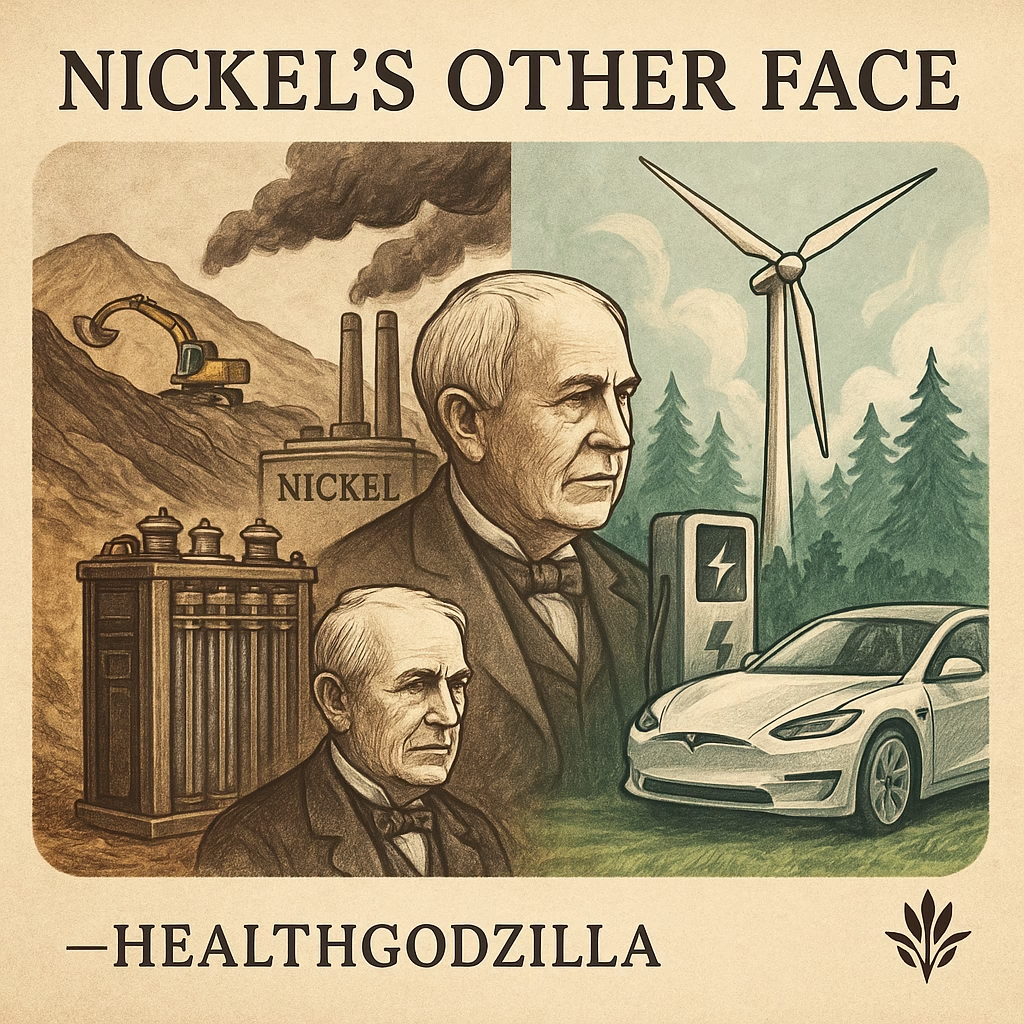
1. Prologue — The Metal That Slips Through Everything
Nickel Toxic Legacy sits in the coin that passes from one hand to another, in the kettle that boils water for morning tea, in the belt buckle that clasps around a waist. It clings to jewelry, glints in cutlery, lines the surface of factory tools.
Silent, it does not announce itself. Instead, through breath in refineries, across the skin of welders, into the bloodstream of children inhaling untested vapes—it enters.
We are told to see it as useful—durable, shiny, essential for stainless steel, batteries, and the electric future. Yet usefulness often carries a shadow. Beneath the gleam, nickel carries a history of illness, of rashes on skin, fibrosis in lungs, cancers in tissues. Indeed, its path is not only chemical but structural: the way economies are built, the way safety is neglected, the way profit speaks louder than precaution.
This is not the story of a single element. Rather, it is the story of how systems allow it to persist, unseen.
2. Nickel in the Workplace — Where Power Meets Exposure
Factories hum with routine: boilers hissing, furnaces glowing, presses hammering. Behind that routine, lives bend. Workers inhale dust from nickel carbonyl, a compound so toxic that one breath can scar the lungs. The International Labour Organization (ILO) notes that welders, platers, battery assemblers—all risk exposure every day. Moreover, the conditions are rarely accidental; they are structured by choices—production targets over protection, efficiency over human breathing.
It is not a mystery. The data is there: exposure linked to nasal cancers, chronic bronchitis, asthma, and hypersensitivity reactions. Governments issue limits—permissible exposure levels measured in fractions of milligrams. However, enforcement often dissolves at the edge of the factory gate. For workers, the “limits” are not an abstraction. They are headaches at the end of a shift, skin eruptions that refuse to heal, breath that tightens when climbing a flight of stairs.
New Jersey’s official reports on toxic sites reveal the Nickel Toxic Legacy of smelting: soils poisoned, aquifers carrying residues long after the furnaces cooled. In each case, workers were first in line—not by choice, but by design. Industrial history is full of such stories. Consequently, the structures that govern production shape the exposures that define health. And when accountability falters, it is not management that breathes the dust.
Nickel, here, is more than an element—it is a mirror of power.
3. Nickel in Everyday Life — Invisible, Intimate, Ignored
Coins passed from hand to hand, kettles whistling on stoves, the clasp of a necklace against the skin. Nickel travels everywhere, so ordinary that its weight is forgotten. Yet the intimacy comes at a cost. Dermatologists call it “the most common cause of allergic contact dermatitis worldwide.” A trace of sweat, a touch of skin—and redness blooms, invisible metals writing themselves into bodies.
The everyday dangers multiply in unregulated markets. A report found illegal e-cigarettes sold in Britain carried nickel at levels 9.6 times above the safe limit. Children inhaled what once poisoned refinery workers. Here, therefore, the line between workplace hazard and consumer risk dissolves. The factory’s dust becomes the teenager’s vapor—a modern shape of the Nickel Toxic Legacy.
Even the mundane is marked. Coins corrode into the dirt, kitchenware leaches into water, cheap jewelry irritates skin. Indeed, each object tells a story of regulation stretched thin, profit outpacing precaution. Nickel hides not as a rare toxin, but as a familiar companion—always at hand, rarely considered.
Furthermore, the intimacy is what makes it dangerous. Not distant, but woven into breath, touch, and bloodstream.
4. Nickel in the Environment — Mining, Batteries, and Shadows of Progress
Nickel is not merely dust in a factory; it is the bedrock of a system that stretches from rainforest mines to urban battery plants. If workplace air was the first theater, the earth itself is the second stage of the Nickel Toxic Legacy.
To dig nickel is to scar land. Indonesia, now the largest producer, clears forests to reach the ore beneath. What was once soil alive with roots, insects, and rainfall patterns becomes a field of tailings—grey, metallic, heavy with runoff. Rivers turn opaque; fish vanish. What is marketed as “green transition” begins here, in wounds not easily healed.
Then comes the transformation: nickel refined, carbonylated, bent toward batteries. The electric car—Tesla, Edison’s battolyser, promises of a world without oil. Yet here, too, shadows: smelters vent sulfur dioxide, dust carries nickel into the lungs of surrounding villages. Children cough near roads lined with “green” infrastructure.
We are told this is progress. But progress for whom? To replace oil with metals mined under equally harsh regimes—does this liberate, or does it shift chains from one set of wrists to another?
Nickel sits at the heart of this paradox: essential for cleaner technologies, yet extracted and refined with methods that poison workers, rivers, and air. The same element that electrifies futures also corrodes present lives, carrying forward the Nickel Toxic Legacy into another century.
And unlike the coin in your pocket, here nickel is unseen, folded into lithium-nickel-cobalt cells, hidden in the casing of a car, humming silently as it charges. It slips into narratives of climate salvation—while its trail of extraction remains buried, out of sight.
The shadows are not only environmental. They are systemic: unregulated markets that allow pollution to be exported, regulatory silences that let smelters burn unchecked. A toxic legacy is justified with the language of necessity.
To face nickel is to face contradiction itself.

5. Nickel’s Other Face — Edison’s Dream and Tesla’s Tomorrow
Once, in the glow of the early 1900s, Thomas Edison staked his faith on a battery built not of lead but of nickel and iron. He called it rugged, a battery for the ages—though the world found it too costly, too stubborn, too heavy. It faded into obscurity, filed away like so many of Edison’s unfinished sketches.
And yet, a century later, the design reappears. In a Dutch lab, engineers call it a battolyser: a fusion of nickel–iron storage with an electrolyzer, able to both hold power and split water into hydrogen. It does what Edison had imagined, but under a different sky. Where his dream stalled in the corridors of industry, today’s energy crisis gives it breath again.
Nickel, the same element threaded into workers’ lungs, now stands at the heart of a transition pitched as salvation. In Tesla’s supply chains, in the electric grids searching for resilience, in the battolyser’s strange rebirth—nickel gleams with promise. The paradox sharpens: the Nickel Toxic Legacy that once scarred miners and left welders with inflamed airways now promises to help steady the climate.
But the paradox is not just technical. It is moral. Can the same material carry both injury and cure, both corrosion and continuity? History suggests it can—and that the deciding factor is never the atom, but the arrangement of power around it.
6. The Unseen Connection — Power, Policy, and Responsibility
Nickel is not guilty.
The system is.
Every miner with scarred lungs, every welder coughing into the night, every child drawing vapor laced with nickel into fragile bronchioles—none of this is inevitable. It is arranged. Structured. Rationalized.
Policies proclaim “limits” of exposure—0.2 mg/m³ here, 1 mg/m³ there. Companies meet them on paper, while dust lingers in the air. Regulators praise “progress,” while studies decades apart repeat the same phrases: dermatitis, asthma, cancer. The continuity is not chemical, but political.
This is the Nickel Toxic Legacy moving invisibly through networks of profit and neglect. Mining contracts in Indonesia reshape forests; subsidies for electric vehicles demand more extraction; policymakers frame recycling targets as solutions, yet often only shuffle the problem downstream. A single gram in a coin is trivial; a million tons in global trade becomes structural violence.
Chomsky often warns: the question is not what happened but who set the conditions that allowed it to happen. Here too, nickel’s story is not one of metallic fate but of governance bent toward market appetite. Edison’s nickel–iron dream dies for lack of profit, then resurrects when investors see hydrogen markets rise.
This is the machinery of narrative: metals cast as heroes or villains, while the machinery of exploitation remains intact. Technical jargon muffles workers’ voices; acronyms bury environmental degradation. Nickel itself is only a mirror, reflecting the priorities of those who command the system.
And so we stand in a world where the same element builds both coins for commerce and chains for workers, batteries for transition and burdens for miners’ lungs. The unseen connection is not nickel, but us—our structures, our silence, our willingness to let the shadow persist if the light looks profitable.
7. Coda: A Metal, A Mirror
Nickel is everywhere—on our skin, in our lungs, buried in forests stripped for ore, gleaming in the promise of green batteries. Yet it is never only nickel. It is a mirror.
The element itself has no morality, no destiny. What matters is the structure in which it is bound. Nickel in a welder’s scar is policy. In a child’s vape, it is regulation ignored. And within a battolyser, profit finally aligns with the language of climate.
If there is a truth to draw, it lies not in chemistry but in memory: how we remember the voices of miners who coughed before electric cars existed; how we recall Edison’s forgotten experiments, with markets erasing them rather than failure; how we hear the silence of workers in today’s factories, whose stories appear only as footnotes in the reports.
A metal can slip through everything, but the mirror it offers cannot be dodged. To look at nickel is to see ourselves—our hunger for speed, our neglect of bodies, our fragile hope that the same tools which harmed may someday heal.
Noorael, the wisdom star, flickers unseen above such stories. Perhaps it does not give answers but light enough to show the outlines. And in that half-light, we are left not with conclusions, but with questions that follow us out of the lecture hall, into the street, into the factories and fields where nickel waits, still indifferent, still ours to reckon with.
🌼 Articles You May Like
From metal minds to stardust thoughts—more journeys await:
- AOL-Time Warner failure: Merger, mindsets, and market myths. Explore culture clash, transient advantage, primacy, and antitrust risks.
- Beryllium exposure risks chiefly in high-tech and heavy industries. Covering workplace hazards, chronic disease, global updated guidelines.
- Biodiversity and nutrition: Reforming diets through agrobiodiversity. Policy, Traditional and Indigenous Foods, and Scientific Relevance.
